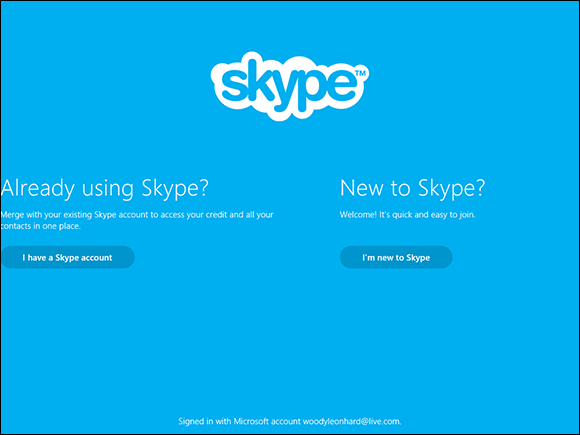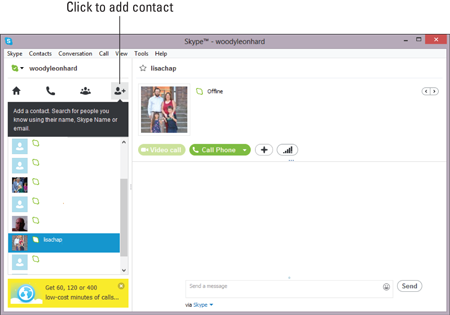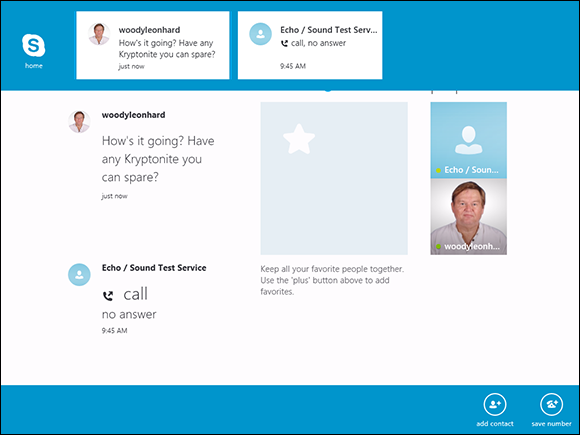Chapter 2: Using Skype in Windows 8.1
In This Chapter
![]() Finding Skype
Finding Skype
![]() Getting signed up for Skype
Getting signed up for Skype
![]() Connecting with Skype
Connecting with Skype
![]() Getting along with Skype
Getting along with Skype
Everybody knows Skype, the instant text-messaging, long-distance, telephone-killing video-chatting program. Not everybody knows that it started as something of a hacker’s fantasy, about a decade ago, in Estonia. Two of the key players in getting Skype to market, Janus Friis from Denmark, and Niklas Zennstrom from Sweden, spent their earlier years getting Kazaa — the notorious filesharing program — off the ground.
It's taken Microsoft a couple years to get around to it, but Windows 8.1 ships with a Metro Skype app fully built-in. You just have to find it, set it up, and use it — but only on the Metro tiled side of Windows 8.1, thank you very much. If you want Skype on the old-fashioned desktop, you have to download it from www.skype.com or you can fire up a web browser and use it like everybody else.
Many hundreds of millions of people use Skype. The last official tally, from December 2010 — before Microsoft took over and stopped publishing statistics — put the number of registered users at 663 million.
Exploring Skype Alternatives
Before you look for Skype on your Windows 8.1 computer, realize that Skype runs on just about anything: iPhone, iPad, Android phones and tablets, Windows XP or later, Windows Phone, Mac OS X, Xbox One, Blackberry — just about anything.
If you only have a desktop connected to the Internet, you don’t have many choices. If you’re using a laptop with a built-in camera and mike, it’ll work, and the picture may be great, but I bet you won’t be impressed by the Skype sound quality. On the other hand, if you have an iPad, or an Android tablet or big-screen phone, you’re going to find that setting up and using Skype is a lead-pipe cinch. Download the app, install it, and everything just works.
Where Can You Find Metro Skype?
Chances are pretty good that the Metro Skype tile didn’t get put on your Metro Start screen. If you’ve looked and can’t find it there, it’s because Microsoft hid it on the All Apps screen. Here’s how to get it back and get started:
1. Go to the Metro Start screen and type skype.
The Metro Skype app should appear as the first choice: The icon looks like a Superman cape (more like a Superman disposable diaper?).
2. Click or tap the Metro Skype icon.
Skype appears, and it already has a question. See Figure 2-1.

Figure 2-1: If Skype runs in the background, it can notify you when calls come in.
 If you’re using a local account to sign in to Windows — as opposed to a Microsoft account — and you crank up Metro Skype, Skype prompts you immediately to switch to a Microsoft account. If you want to use Metro Skype, you must have a Microsoft account.
If you’re using a local account to sign in to Windows — as opposed to a Microsoft account — and you crank up Metro Skype, Skype prompts you immediately to switch to a Microsoft account. If you want to use Metro Skype, you must have a Microsoft account.
3. Most people like Skype to ring — or toss off some other notification — if there’s an inbound Skype call. If you’re one of those people, tap or click Allow.
Realizing that many people using the Metro Skype app already have Skype accounts, Metro Skype asks if you want to use an existing Skype account, or if you want to create a new, ahem, Microsoft account, as in Figure 2-2.
4. If you already have a Skype Name and you want to tie it in to your Windows account, click or tap I Have a Skype Account, on the left.
If you really don’t want Microsoft to associate your existing Skype Name with your Windows account, click or tap I’m New to Skype, on the right. And, of course, if you don’t yet have a Skype name, click the latter.
If you click on the left, Skype asks for your existing Skype Name and password, then bundles that with your Microsoft account. If you click on the right, you have a chance to sign up for more spam (oh boy!), and you’re set up with your Microsoft account as your Skype Name.

Figure 2-2: The answer to this question isn’t as obvious as it may appear.
When Metro Skype is ready to roll, you see a screen like the one in Figure 2-3.

Figure 2-3: A clean, new Skype account in the Metro Skype app.
5. Start by running an Echo/Sound Check. Click or tap the tile on the right that says Echo/Soun . . .
Metro Skype brings up a Sound Check dialog box, where you can check your microphone and speakers.
6. Follow the instructions to test that your mike and speakers are working — and your camera, too, if it’s connected.
The test is quite simple and only takes 30 seconds.
If you’re only interested in using the Metro Skype app, skip down to the section called Making First Contact. But if there’s a chance you’re going to want to run Skype on the old-fashioned desktop, continue with the next section.
Installing “Legacy” Skype
I use the term “legacy” a bit tongue-in-cheek here because Skype on the Windows desktop is considerably more powerful than Metro Skype. But I digress. Here’s how to put the regular, old, everyday Windows version of Skype on your Windows 8.1 machine:
1. Get your favorite browser going and head to www.skype.com.
You see a very fancy landing page, with all the hallmarks of a Microsoft Metro web page.
2. Up at the top, click or tap Downloads.
You see another fancy Metro-inspired page. At the bottom it says Get Skype for Windows 8. That’s NOT the button you want to push — if you go that way, you get steered (eventually) to the Metro Skype app.
3. Scroll down the page to the Or Choose Another Version section, and then click Learn about Skype for Windows Desktop.
You see another fancy . . . well, you get the idea. Somewhere near the bottom of the page, you see a button marked Get Skype for Windows Desktop.
4. That’s the button you want to click.
5. Follow the instructions to download the installer and run the installer.
You see an Installing Skype dialog box like the one in Figure 2-4.

Figure 2-4: Would you like to be a link in the chain?
6. Click or tap I Agree – Next.
If you use Skype all the time, by all means keep the Run Skype When the Computer Starts box checked. If you allow Skype to run all the time, it acts as a conduit for Skype conversations all around you — passing those conversations through your computer and sending them out the other side. If you’re a heavy Skype user, you’re under some sort of moral obligation to keep the whole chain working. On the other hand, if you only use Skype occasionally, you’d be forgiven if you only support the Skype effort when you’re using it. Personally, I don’t use Skype very much, so I deselect the box.
Microsoft, er, Skype, then presents you with an option to use Click to Call. The idea’s pretty simple: If you’re on a web page with a phone number, Skype can scrape the number off the page and offer to call it. It’s a free service, but it can be a bit annoying, especially if you never call regular phone numbers using Skype. (Granted, calling by Skype is cheaper than using the regular phone, but Skype-to-Skype is infinitely cheaper!)
7. Uncheck the Install Skype Click to Call box and choose Continue.
Then Microsoft, er, Skype, so kindly offers to make Bing your default search engine and make MSN your home page. Er, NOT!
8. Uncheck the boxes to make Bing your default search engine and make MSN your home page, and choose Continue.
Skype whirs and clicks for a while, gets itself installed, and sets up that pass-through communication, and ultimately you get to the sign in screen shown in Figure 2-5.

Figure 2-5: The many sign-in paths to enlighten-ment, Skype-style.
9. You will probably get a Windows Firewall blocking notice, saying that the firewall is blocking Skype. Yes, that’s a Microsoft product blocking a Microsoft product as part of a normal Microsoft installation. Check the box allowing Skype to communicate over Private networks. Unless you want to use Skype while connected to a public Wi-Fi service (which sounds reasonable, but it’s not very secure), deselect the second box. Select Allow Access.
Skype presents a Sound Check dialog box, saying you’re nearly done. If your mike, speakers, and camera work, they’re actually telling the truth.
10. Click Continue.
Skype shows you the sound/camera check in Figure 2-6.

Figure 2-6: I’m a happy camper because my headset, mike, and camera are all working. Simultan-eously.
11. If something isn’t working, now’s the time to figure out what and why and how. When you have three thumbs up, click or tap Continue.
The setup offers to pin a profile picture on your ugly mug — or is it the other way around? — and you can certainly do so, if that’s your thing.
You’re ready to start using Skype.
Making First Contact
Each of the different versions of Skype — Metro, Windows, iPad, Android, and so on — presents a slightly different way of working, but they all have the same basic core features. The locations on the screen may vary, but the actions are all quite similar.
The old-fashioned desktop version of Skype looks like Figure 2-7.
The three orientation points:
![]() Contacts (sometimes called People in the Metro Skype app) are all the people you can call. Getting a person added to your Contact list is not a one-way street: You have to ask the person, and he must give permission before you’re allowed to call him. See the next section.
Contacts (sometimes called People in the Metro Skype app) are all the people you can call. Getting a person added to your Contact list is not a one-way street: You have to ask the person, and he must give permission before you’re allowed to call him. See the next section.
![]() Favorites are Contacts — approved and accepted — that you pin to the Favorites list. Keeps the riff-raff down when you’re speed dialing.
Favorites are Contacts — approved and accepted — that you pin to the Favorites list. Keeps the riff-raff down when you’re speed dialing.
![]() Recent has entries for all your recent instant messages and voice/video conversations.
Recent has entries for all your recent instant messages and voice/video conversations.

Figure 2-7: Skype is ready to go.
If you can figure out how to get to each of those three points on whatever device you use — desktop, laptop, tablet, phone, wristwatch, keyfob — you’ll have 90 percent of the Skype shtick down.
Adding a Contact
Before you can call someone, you have to make her an “official” Contact — which means you have to ask for, and receive, permission to call.
1. On the main screen (see Figure 2-7), click the Add a Contact icon, which looks like a disembodied head with a plus sign next to it.
2. Type something into the search box.
In this case (Figure 2-8), I type the name of my good buddy mxyzptlk2. Skype searches its billion-name-or-so database and comes up with a few hits.

Figure 2-8: Looking for Mr. Mxyzptlk2.
3. Click on the most likely hit (sometimes it’s hard figuring out whom to pick; try narrowing the search argument).
Skype responds on the right by saying the person you chose is not in your Contacts.
4. Click I knew that, silly Skype, that’s why I’m adding him to my Contacts list, and then Add to Contacts.
Skype responds by creating a reasonable message — shown in Figure 2-8 — and offers it to you for sending to the new Contact.
5. Click Send.
If your Contact-to-be is online, he’ll see a message like the one in Figure 2-9.
6. Wait.
If your Contact-to-be clicks or taps on the invitation, and then clicks Accept, you will suddenly find yourself with an acceptance notification, and you’ll immediately be flung into a conversation, as shown in Figure 2-10.

Figure 2-9: A Contact request, as seen from the Metro Skype app.

Figure 2-10: Contact request accepted, and the conversa-tion begins immediately.
7. Type to your heart’s content, and when you’re done with this and any other conversations, click or tap Skype⇒Sign Out.
Skype continues to run — it can notify you of any incoming calls — but it shows you as Offline.
Adding a Contact in the tiled Metro version of Skype is similar, but the cues are a little different. To add a Contact, go to the main Metro Skype page (see Figure 2-3) and right-click the main part of the screen, or swipe up from the bottom. You see the App bar shown in Figure 2-11.
The basic sequence of steps are the same as if you were working in the (much more information-dense, and easier to navigate) old-fashioned desktop version of Skype. When it’s time to send a message to your Contact-to-be, you get a screen like that shown in Figure 2-12.

Figure 2-11: To add a Contact in the Metro version of Skype, you have to right-click or swipe to bring up the App bar.

Figure 2-12: The Metro Skype version of the screen shown in Figure 2-8. You get to choose which you like better.
After you get your Contacts going, I think you’ll find it very easy to bring up old conversations and add a Contact to your favorites list. (Hint: On the desktop, right-click the Contact and choose Add to Favorites; in Metro, tap and slide or click and hold and . . . er . . . uh . . . I forget . . . let’s see, do you slide from the right, or pinch the pic? . . . is it in the App bar? . . . the Settings charm? . . . no . . . oh, I see it, click or tap that little + sign to the right of the word Favorites, and then choose by scrolling through your entire list of Contacts).
A Few Tips from Skype-ologists
By default, people can call you if they have your Skype Name (or, by extension, your Microsoft Account name). You don’t have to answer. If you want to disable that capability — so only people in your Contacts can get through to you — check Tools, Options, Privacy Settings in the desktop version of Skype, or bring up the Settings charm in Metro.
The Metro version of Skype comes pre-installed with Windows 8.1. You may or may not be able to find the Skype tile (which says, simply, Skype) on your Metro Start screen. If you want to put it there, follow the instructions in Book III, Chapter 1 to move the tile from the All Apps list to the Metro Start screen.
Skype-to-Skype calls are free. But Skype has many, many more options, that aren't free. You will probably find that the Skype options are much, much cheaper than normal long-distance phone charges. There are promotions all the time and lots of ways to game the system. See www.skype.com just for starters.

 Microsoft bought Skype, lock, stock and barrel camera, in 2011, for a paltry $8.5 billion — yes, that’s billion with a “b.” The brass moved to Redmond, but most of the techies are still in Tallinn and Tartu, Estonia.
Microsoft bought Skype, lock, stock and barrel camera, in 2011, for a paltry $8.5 billion — yes, that’s billion with a “b.” The brass moved to Redmond, but most of the techies are still in Tallinn and Tartu, Estonia. The methods for adding Contacts vary depending on which version of Skype you’re using. Here’s how to add a Contact in the old-fashioned desktop version of Skype:
The methods for adding Contacts vary depending on which version of Skype you’re using. Here’s how to add a Contact in the old-fashioned desktop version of Skype: